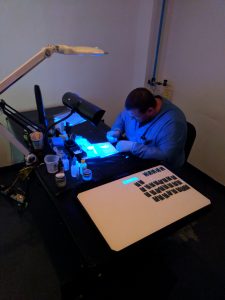Properties of Acrylic Conformal Coating
Posted by Sean Horn
Friday, February 16, 2018 8:11
@ 8:11 AM
Exceptionally user-friendly, liquid acrylic resin (AR) conformal coatings protect printed circuit boards (PCBs) and similar electronics from corrosion, dirt/dust, fungus, moisture, and thermal shocks. AR’s ease of application contributes to its status as the most frequently used conformal material.
Liquid Application Methods for AR
The primary means of AR liquid application are brush, dipping (immersion) and spray. Each has merits and disadvantages relative to the other techniques.
 Brush Application
Brush Application
Simple, cost-effective manual brush-coating is recommended for smaller-batch acrylic assignments. Larger-volume brushing is time-consuming and costly, often resulting in often inferior surface finish, with defects like film-bubbles commonplace. Brushing also covers only one side of an assembly at a time, further slowing production. Skilled operators are suggested for film-application to assure quality outcomes of appropriate thickness. Overly-thick films can crack during thermal cycling, leaving the component vulnerable to contamination and dysfunction; films that are too thin cause similar problems. Additionally, brushing is ineffective for coating complicated/irregular PCB surfaces, which obstruct film uniformity.
Brushing is quick, but development of these problems is possible, regardless of the operator’s experience or skill-level, limiting reliable brush-technique opportunities.
Dipping
Unlike brushing, AR-dipping is very-repeatable and fast, allowing higher-level production runs. Electrical assemblies are submerged in a dip-tank containing the liquid AR-solution, through either manual or automated processes. Completely immersed, coating coalesces around the unit, with dependable under-component penetration.
Nevertheless, inconsistent edge/tip coverage and irregular coating thickness can occur; expert manual masking is required to protect keep-out areas. Otherwise, potential leakage limits dipping-application for many assignments.
Spray Coating AR
Cost-effective manual or automated spray techniques work well with AR films. They provide coating-surface quality superior to either brush/dip, if the designated assembly has been properly cleaned and AR-coating type has no adhesion issues relative to the substrate material. Automated spray processes are recommended for high-volume spray assignments, generating faster turn-around and better coating accuracy, with reduced masking requirements. Low/medium volume coating assignments are effectively enacted with dedicated spray booth coating employing aerosol/spray-gun application. In these cases, processing with a skilled operator can generate finish superior to all other methods
Despite the relative drawbacks of each method, brush, dip and spray processes are easily implemented. In each case, the selected AR-type’s properties (chemical, electrical, physical, etc.) in relation to its compatibility with PCB material and function is a major determinant of coating method used.
AR Performance Properties
In accordance with IPC-610, AR is typically applied at thicknesses between 0.002 – 0.005 inches (2-5 millimeters). Fungus-resistant acrylic is easily applied and cures in as little as 30 minutes at room temperature, making it a good choice if the objective is rapid production. Simple liquid application methods typically result in the fastest turnaround-time of all conformal coatings. AR’s moisture protection is also very highly-rated, adding to its utility for a wide range of coating uses.
As a one‐part system, simplified AR-application combines with ease of rework to give both manufacturer and client low material/production cost. AR coatings respond to solvent-removal for repair purposes. However, this same trait – inability to withstand weaker solvents like isopropyl alcohol or xylene — also makes acrylic incompatible for coating assemblies experiencing prolonged solvent-contact during operation.
With an effective operating temperatures range from -65’C through +125’C, AR does not withstand temperatures above 130° C, eliminating its use for electronics intended for higher-heat operational environments. Despite lower abrasive/chemical and solvent resistance, AR coatings nevertheless provide good acid/base protection, and fungus resistance.
With moderate surface elasticity and protective qualities, acrylic conformal films also have high dielectric strength, equaling V 300/mm.; dielectric constant is 2.5, with a dissipation factor of 0.01. Superior dielectric properties withstand most incidents of static/voltage discharge, adding to PCB functionality and longevity.
Superior moisture protection is AR’s most identifiable performance characteristic, providing reliable, long-lasting defense from liquidized threats to component performance. Most prominent are humidity and other forms of moisture condensation during assembly operation; AR coatings resist moisture-development within the assembly. Similar liquid performance hazards — rain/salt seawater and water spray – do not penetrate acrylic coatings. Achieving maximal physical properties in minutes. clear-drying AR conformal films also:
- can be soldered through if necessary,
- display low glass-transition temperatures,
- fluoresce under UV light, further simplifying inspection, and
- retain considerable surface flexibility, post-application.
Repair is as easily initiated as application, properties that generate AR’s low production/maintenance costs. Driven by labor expenses and process complexity, acrylic’s manufacturing costs are lower, because they require less completion-time than competing conformal film materials, whether liquid epoxy, silicone or urethane, or vapor-deposited parylene.
Summary
The most commonly used compound in the conformal coating industry, acrylic resins provide superior moisture defense, fair surface elasticity and overall component protection, with high dielectric strength and simplified removal/rework. These benefits recommend AR films for a wide range of less complex conformal coating assignments.
To learn more about acrylic conformal coatings, download our whitepaper now:
Download our guide on Acrylic Resins 101
Comments
Homepage 4/17/2020. 10:17:10 AM
... [Trackback] [...] Informations on that Topic: blog.paryleneconformalcoating.com/whats-the-difference-between-potting-and-conformal-coating/ [...]

londondrugscanada.bigcartel.comlondon-drugs 4/17/2020. 10:17:10 AM
cialis uk https://londondrugscanada.bigcartel.com/london-drugs This is nicely expressed. !